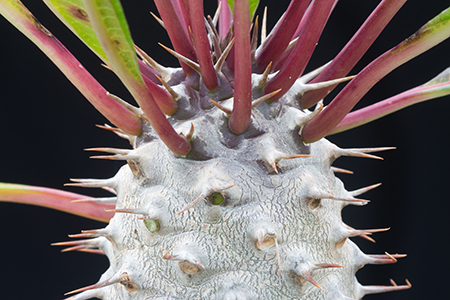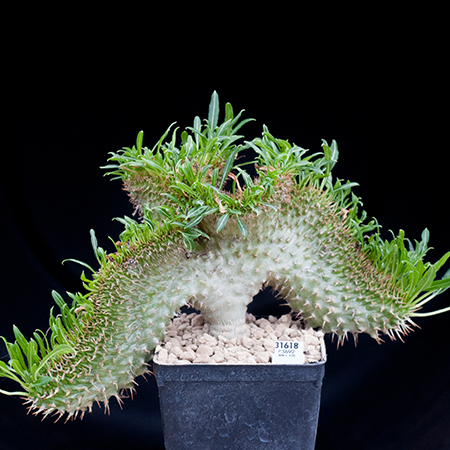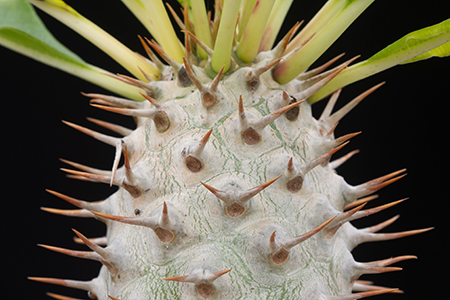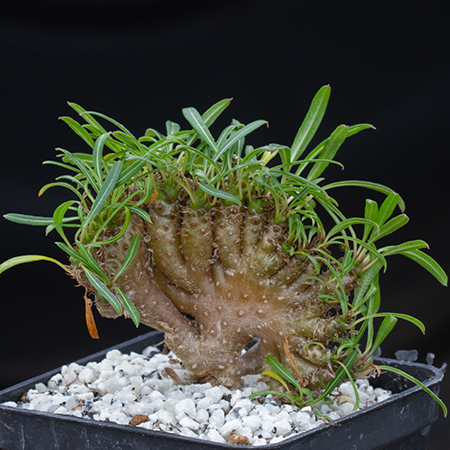Pachypodium fiehrensis

Originally from Atsimo east of Toliara, in Madagascar, it is a type of Pachypodium lamerei of reduced size. The spines are shorter and less frequent, and the stem thickens noticeably even in the younger specimens. Other differences from the typical P. lamerei are the more coriaceous and thin leaves and the highly perfumed flowers produced by specimens at least one meter high. Very robust, the species seems to easily tolerate temperatures at the 0 °C limit.
| Botanical name | Pachypodium lamerei var. fiehrensis is a nomen nudum (n.n.) that is a name that has not been validly published. It refers to a possible place of origin of the plants originally collected (Fiherenana River, Madagascar). |
|---|---|
| Flying Dragon | It is the crested form. Each specimen is produced from seed, so it shows original and distinct characteristics. The forms of Flying Dragon are sometimes very small (1-2 cm in diameter) as they develop immediately after germination, or they can measure a few decimeters if the fasciation (the production of the crest) is expressed in specimens of some years of age. |
| Rubin | It is a variant of the natural form, which colour of the epidermis of the stem and the petioles of the leaves is ruby red. Unfortunately the color of the stem is quickly masked by the thick greyish cuticle that protects the epidermis. |
| Polycephalus | It is a monstrous form consisting of plants with multiple stems. If the branches form directly in the germination phase their number is limited to a few units, but sometimes the Polycephalus form early starting from a crested plant, giving rise to myriads of stems which then develop into their natural form. |
In recent years, after a long and patient selection work, we have managed to obtain a certain number of specimens that show interesting teratopic forms, which we are finally able to offer for sale to interested customers. All the plants offered are characterized by remarkable robustness, obtained by adopting natural cultivation techniques that minimize the use of organic substrates and nitrogen fertilizers.
Cultivation tips
These plants show remarkable strength and resistance to the main adversities compared to other tree-like species of Pachypodium like P. lamerei or P. geayi. In particular, they tolerate radical containment (very small pots do not limit their development), winter temperatures close to freezing, prolonged dryness and absent fertilizations.
Very high temperatures associated with exposure in full sun can cause deep burns to the stem, never lethal but certainly damaging to the aesthetics of the specimens. Sturdy plants have a thick protective cuticle in the most exposed part, so it is suggested to always maintain the same position of the plants with respect to the incident light (do not turn the pots).
Some crested or monstrous small forms may be more sensitive to adversity.
 Apex of a P. fiehrensis specimen from our 'Ruby' selection.
Apex of a P. fiehrensis specimen from our 'Ruby' selection. 'Dragon flying' crested form.
'Dragon flying' crested form. Apex of a specimen of P. fiehrensis of the common form.
Apex of a specimen of P. fiehrensis of the common form. Monstrous form 'Policephalus'.
Monstrous form 'Policephalus'.
